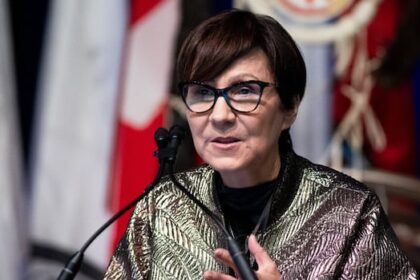British Columbia·NewSome local leaders in northwestern B.C. say Ottawa’s decision to fast-track two massive energy projects will boost the region’s economy — but stress that cities like Terrace and Prince Rupert need urgent, long-term investments to handle the growth. Northwest B.C. now has four major projects on the federal fast-track listShaurya Kshatri · CBC News · Posted: Nov 14, 2025 8:00 AM EST | Last Updated: 26 minutes agoListen to this articleEstimated 4 minutesThe audio version of this article is generated by text-to-speech, a technology based on artificial intelligence.A rendering of the Ksi Lisims LNG project, a floating production facility capable of producing 12 million tonnes of liquefied natural gas per year. The project is among two more in northwest B.C. that are part of a federal fast-track list — with local mayors asking for more investment to handle them. (Submitted by Ksi Lisims LNG)Some local leaders in northwestern B.C. say Ottawa’s decision to fast-track two massive energy projects will boost the region’s economy — but stress that cities like Terrace and Prince Rupert need urgent investments to handle the accompanying growth.Prime Minister Mark Carney, speaking in Terrace on Thursday, announced that Ksi Lisims LNG and the North Coast Transmission Line have been forwarded to the Major Projects Office for consideration. This means northwestern B.C. now has four initiatives on the federal priority roster, including the LNG Canada Phase 2 in Kitimat and the expansion of the Red Chris copper mine.Ksi Lisims, a floating export facility involving a natural gas pipeline across the north, is set to add $4 billion a year to the nation’s GDP, Carney said. Prime Minister Mark Carney takes a photo with B.C. Hydro workers after the major projects announcement at Skeena Substation in Terrace, B.C., on Thursday. (Ethan Cairns/The Canadian Press)To power it, there is the North Coast Transmission Line — a 450-kilometre power line between Prince George and Terrace, which Carney said also has the potential to create another $10 billion in new economic activity and is to be extended into the Yukon.“Unlocking these resources … will attract hundreds of billions of dollars in new investment and create thousands of high-paying careers for miners, carpenters, and engineers across the country,” the prime minister said. WATCH | What’s next for seven ‘nation-building’ projects:What’s next for the 7 new projects announced by Mark Carney? | Hanomansing TonightOn Thursday, Prime Minister Mark Carney announced seven more initiatives he’s recommending for fast-tracked approval by the government’s Major Projects Office. CBC’s Caroline Barghout walks us through the new projects, what’s next, and reaction from First Nations.More opportunities, more problemsTerrace Mayor Sean Bujtas says the projects signal enormous potential for northern communities — but said the city of around 12,000 cannot be expected to absorb their impacts without long-term help from both the provincial and the federal governments.”We really are the epicentre of all these new major projects that are happening,” he said.“These projects are great for the provincial and federal economy — but the City of Terrace does not receive any taxation from any of these projects, yet they receive the burden,” he added.Sean Bujtas, mayor of Terrace, said he’s worried about impacts on his community without long-term investments. (Maggie MacPherson/CBC)The province’s Northwest B.C. Resource Benefits Alliance agreement has delivered more than $34 million to Terrace since 2024, money the city says it has used to upgrade roads and its downtown core — but Bujtas noted it’s a five-year deal that will expire in 2029.Since 2018, the construction of the $40-billion LNG Canada facility near Kitimat has already strained local resources.And now with more projects coming to northwestern B.C., Bujtas says the pressure will only intensify. Terrace, he said, needs sustained funding for housing, transportation, sewer systems and other core infrastructure.“We, as northerners, are up to the task to do our fair part,” Bujtas said. “But we’re going to need a little support to help do that.”The proposed site for the Ksi Lisims LNG project. (CBC News)Ksi Lisims LNG has said that it plans to reduce community impacts by housing all construction and operations workers “at the facility’s remote location.” “This will mean less pressure on housing, traffic, health and social services in northwestern B.C.,” it says in a promotional video.In Prince Rupert, Mayor Herb Pond called himself a “fan” of the projects and said reliable power is a missing piece for the port city.Pond says a former pulp mill site on the waterfront could support a hydrogen facility, but limited power has stalled that opportunity. “There are a whole bunch of economic opportunities in the whole region that can be unlocked with power,” he said.Even as the prime minister and some local leaders have hailed the projects’ economic potential, the proposed megaprojects have faced criticism. While the Nisga’a Nation is a partner in Ksi Lisims LNG, some other First Nations have not granted consent or have gone to court to challenge it.WATCH | Pipeline required for Ksi Lisims LNG raises concerns:Local communities worried about pipeline required for Ksi Lisims LNGKathy Clay, president of the Kispiox Valley Community Centre Association and Chief Councilor Kolin Sutherland-Wilson of the Kispiox Band explain their concerns about the proposed pipeline.Health care remains a critical gapThe announcement also lands amid persistent emergency room closures across northern B.C. — a barrier B.C. Health Minister Josie Osborne says must be addressed to match the growth in the region.“How can we attract families, attract new businesses, attract investments if people can’t access the health care that they need?” she said.LISTEN | Josie Osborne addresses ER closures in northern B.C.:Daybreak North9:26Health minister in Terrace and KitimatJosie Osborne addresses Burns Lake ER closures.Osborne said the province is recruiting more doctors and nurses and investing in new facilities, including an expanded emergency department in Prince Rupert.“It’s important for everybody to remember that underlying all of this economic activity … we need a strong health-care system underlying that.”ABOUT THE AUTHORShaurya Kshatri is a web writer and reporter at CBC News Vancouver. You can reach him at shaurya.kshatri@cbc.caWith files from Daybreak North, Hanna Petersen and The Canadian Press
Can northwest B.C.’s infrastructure handle Ottawa’s 4 ‘nation-building’ projects?











